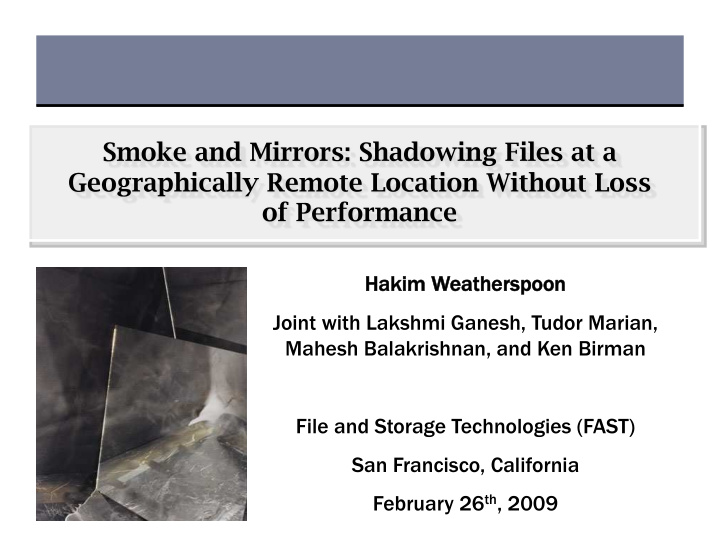



Hakim W Hakim Weather eatherspoon spoon Joint with Lakshmi Ganesh, Tudor Marian, Mahesh Balakrishnan, and Ken Birman File and Storage Technologies (FAST) San Francisco, California February 26 th , 2009
U.S. Department of Treasury Study • Financial Sector vulnerable to significant data loss in disaster • Need new technical options Risks are real, technology available, Why is problem not solved?
Conundrum: async there is no middle ground sync Primary site Remote mirror Want asynchronous performance to local data center And want synchronous guarantee
Conundrum: there is no middle ground sync Remote-sync Local-sync Primary site Remote mirror Want asynchronous performance to local data center And want synchronous guarantee
How can we increase reliability of local-sync protocols? • Given many enterprises use local-sync mirroring anyways Different levels of local-sync reliability • Send update to mirror immediately • Delay sending update to mirror – deduplication reduces BW
Introduction Enterprise Continuity • How data loss occurs • How we prevent it • A possible solution Evaluation Discussion and Future Work Conclusion
Rather, where do failures occur? Packet Partition loss Site Power Failure Outage Primary site Remote mirror Rolling disasters
Network-sync Remote-sync Local-sync Primary site Remote mirror Wide-area network
Primary site Data Packet Remote mirror Repair Packet Network-level Ack Storage-level Ack Use network level redundancy and exposure • reduces probability data lost due to network failure
Network-sync increases data reliability • reduces data loss failure modes, can prevent data loss if • At the same time primary site fail network drops packet • And ensure data not lost in send buffers and local queues Data loss can still occur • Split second(s) before/after primary site fails… • Network partitions • Disk controller fails at mirror • Power outage at mirror Existing mirroring solutions can use network-sync
A file system constructed over network-sync • Transparently mirrors files over wide-area • Embraces concept: file is in transit (in the WAN link) but with enough recovery data to ensure that loss rates are as low as for the remote disk case! • Group mirroring consistency
V1 R1 I1 I2 B1 B2 B3 B4 append ( B1,B2 ) V1 R1 I2 B4 B3 I1 B2 B1 append ( V1.. )
Introduction Enterprise Continuity Evaluation Conclusion
Demonstrate SMFS performance over Maelstrom • In the event of disaster, how much data is lost? • What is system and app throughput as link loss increases? • How much are the primary and mirror sites allowed to diverge? Emulab setup • 1 Gbps, 25ms to 100ms link connects two data centers • Eight primary and eight mirror storage nodes • 64 testers submit 512kB appends to separate logs Each tester submits only one append at a time
Local- Network- Remote- sync sync sync Primary site Remote mirror - 50 ms one-way latency - FEC(r,c) = (8,3) Local-sync unable to recover data dropped by network Local-sync+FEC lost data not in transit Network-sync did not lose any data • Represents a new tradeoff in design space
100000 Local- Network- Remote- 10000 sync sync sync 1000 # Messages Primary site Remote mirror 100 10 - 50 ms one-way latency - FEC(r,c) = (8, varies ) 1 - 1% link loss 0.1 0 1 2 3 Value of C Local-sync+FEC total msgs sent Network-sync total msgs sent Unrecoverable lost msgs c = 0, No recovery packets: data loss due to packet loss c = 1, not sufficient to mask packet loss either c > 2, can mask most packet loss Network-sync can prevent loss in local buffers
App throughput measures application perceived performance Network and Local-sync+FEC tput significantly greater than Remote-sync(+FEC)
Introduction Enterprise Continuity Evaluation Discussion and Future Work Conclusion
Do (semi-)private lambda networks drop packets? • E.g. Teragrid Cornell National Lambda Rail (NLR) Rings testbed • Up to 0.5% loss Scale network-sync solution to 10Gbps and beyond • Commodity (multi-core) hardware
Do (semi-)private lambda networks drop packets? • E.g. Teragrid Cornell National Lambda Rail (NLR) Rings testbed • Up to 0.5% loss Scale network-sync solution to 10Gbps and beyond • Commodity (multi-core) hardware
Introduction Enterprise Continuity Evaluation Discussion and Future Work Conclusion
Technology response to critical infrastructure needs When does the filesystem return to the application? • Fast — return after sending to mirror • Safe — return after ACK from mirror SMFS — return to user after sending enough FEC Network-sync: Lossy Network Lossless Network Disk! Result: Fast, Safe Mirroring independent of link length!
Questions? Email: hweather@cs.cornell.edu Network-sync code available: http://fireless.cs.cornell.edu/~tudorm/maelstrom Cornell National Lambda Rail (NLR) Rings testbesb http://www.cs.cornell.edu/~hweather/nlr
Recommend
More recommend